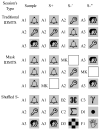Generalized Identity Matching to Sample after Multiple-Exemplar Training in Capuchin Monkeys
- PMID: 25435596
- PMCID: PMC4243937
- DOI: 10.1007/s40732-014-0035-x
Generalized Identity Matching to Sample after Multiple-Exemplar Training in Capuchin Monkeys
Abstract
A multiple-exemplar identity matching-to-sample baseline was established to encourage development of generalized IDMTS performances in three adult male capuchins. Mask (blank comparison) or Shuffled S- procedures were used to promote select (sample-S+) control in baseline relations and to assess stimulus control relations in generalized IDMTS tests. The IDMTS baseline comprised eight 3-stimulus sets or four 4-stimulus sets. Probe trials with new stimulus sets were substituted for baseline sets in successive testing sessions and subsequently converted to new baseline relations. All monkeys exhibited high accuracy on generalized IDMTS tests. A monkey who was given the Mask procedure in training and tests showed generalized IDMTS with select relations predominating. Two monkeys who were given training and testing with the Shuffled S- procedure performed somewhat better on Shuffled S- IDMTS test trials than on test trials that contained non-shuffled test IDMTS trials thus suggesting that exclusion of familiar nonmatching comparison stimuli from baseline in Shuffled S-test trials contributed to the higher accuracy scores with the former procedures. Development of select relations appeared to be a positive predictor of development of generalized IDMTS.
Keywords: capuchin monkeys; generalized identity matching-to-sample; multiple-exemplar training; select and reject relations.
Figures
Similar articles
-
The search for symmetry: 25 years in review.Learn Behav. 2009 May;37(2):188-203. doi: 10.3758/LB.37.2.188. Learn Behav. 2009. PMID: 19380896 Free PMC article. Review.
-
A note on select- and reject-controlling relations in the simple discrimination of capuchin monkeys (Cebus apella).Behav Processes. 2005 Jun 30;69(3):295-302. doi: 10.1016/j.beproc.2004.12.005. Behav Processes. 2005. PMID: 15896528
-
Blank-comparison matching-to-sample reveals a false positive symmetry test in a capuchin monkey.Psychol Neurosci. 2014 Jun 1;7(2):193-198. doi: 10.3922/j.psns.2014.008. Psychol Neurosci. 2014. PMID: 25383161 Free PMC article.
-
This or not that: select and reject control of relational responding in rats using a blank comparison procedure with odor stimuli.Anim Cogn. 2024 Jun 17;27(1):44. doi: 10.1007/s10071-024-01881-7. Anim Cogn. 2024. PMID: 38884865 Free PMC article.
-
An update on the search for symmetry in nonhumans.J Exp Anal Behav. 2021 Jan;115(1):309-325. doi: 10.1002/jeab.647. Epub 2020 Nov 22. J Exp Anal Behav. 2021. PMID: 33225440 Review.
Cited by
-
Generalized, cross-modal, and incrementing non-matching-to-sample in rats.Learn Behav. 2023 Mar;51(1):88-107. doi: 10.3758/s13420-023-00571-7. Epub 2023 Jan 25. Learn Behav. 2023. PMID: 36697934
-
A successful search for symmetry (and other derived relations) in the conditional discriminations of pigeons.Conductual. 2015 Apr;3(1):4-25. Conductual. 2015. PMID: 28386579 Free PMC article.
-
A NOVEL METHOD FOR TEACHING THE FIRST INSTANCES OF SIMPLE DISCRIMINATION TO NONVERBAL CHILDREN WITH AUTISM IN A LABORATORY ENVIRONMENT.Psychol Rec. 2008;58(2):229-244. doi: 10.1007/BF03395613. Psychol Rec. 2008. PMID: 19606260 Free PMC article.
-
The search for symmetry: 25 years in review.Learn Behav. 2009 May;37(2):188-203. doi: 10.3758/LB.37.2.188. Learn Behav. 2009. PMID: 19380896 Free PMC article. Review.
-
Abstraction, Multiple Exemplar Training and the Search for Derived Stimulus Relations in Animals.Perspect Behav Sci. 2017 Nov 1;41(1):45-67. doi: 10.1007/s40614-017-0112-y. eCollection 2018 Jun. Perspect Behav Sci. 2017. PMID: 32004363 Free PMC article.
References
-
- Alfaro JWL, Silva JS, Rylands AB. How different are robust and gracile capuchin monkeys? An argument for the use of Sapajus and Cebus. American Journal of Primatology. 2012;74:273–286. - PubMed
-
- Barros RS, Galvão OF, McIlvane WJ. Generalized identity matching-to-sample in Cebus apella. The Psychological Record. 2002;52:441–460. Retrieved from http://opensiuc.lib.siu.edu/tpr/vol52/iss1/ - PMC - PubMed
-
- Brino ALF, Galvão OF, Barros RS. Successive identity matching to sample tests without reinforcement in Cebus apella. Ciências & Cognição. 2009;14(2):02–11. Retrieved from http://www.cienciasecognicao.org.
Grants and funding
LinkOut - more resources
Full Text Sources
Other Literature Sources


